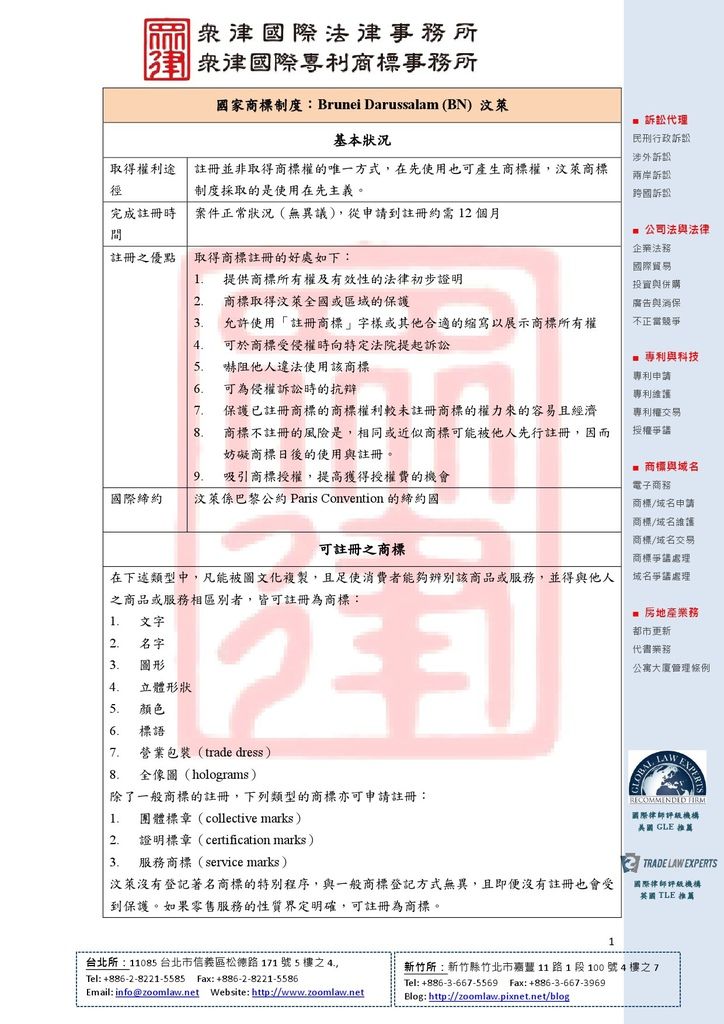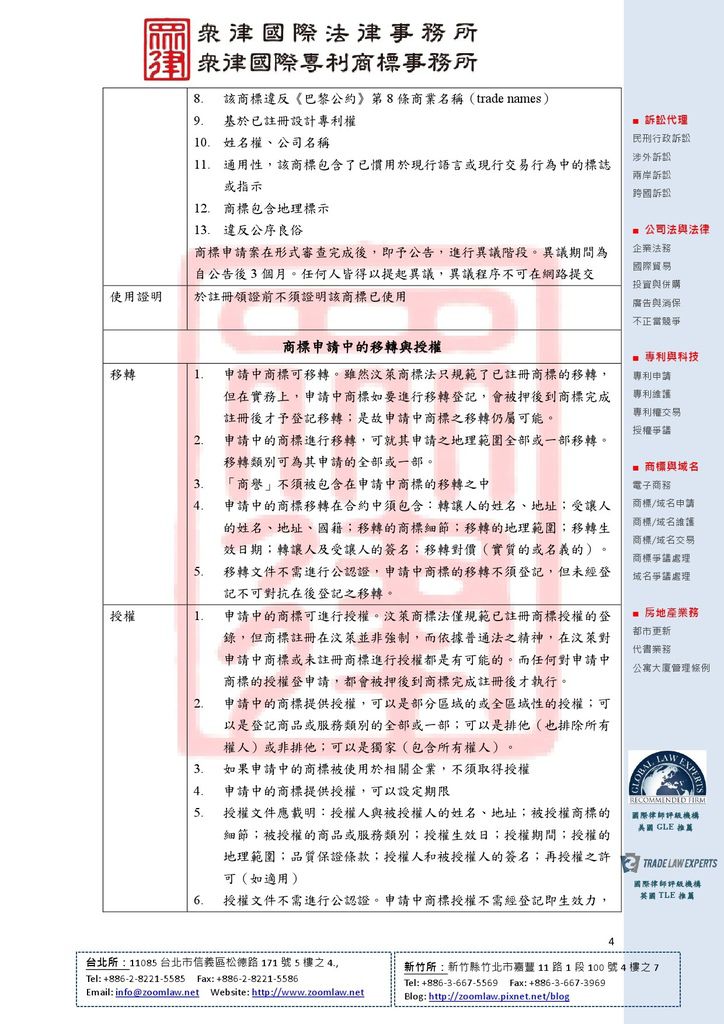








世界各國商標註冊~品牌行銷與商標布局
- Jun 12 Fri 2015 13:55
香港商標制度介紹 眾律國際編譯中心
- Jun 03 Wed 2015 17:00
伊朗商標制度介紹 眾律國際編譯中心





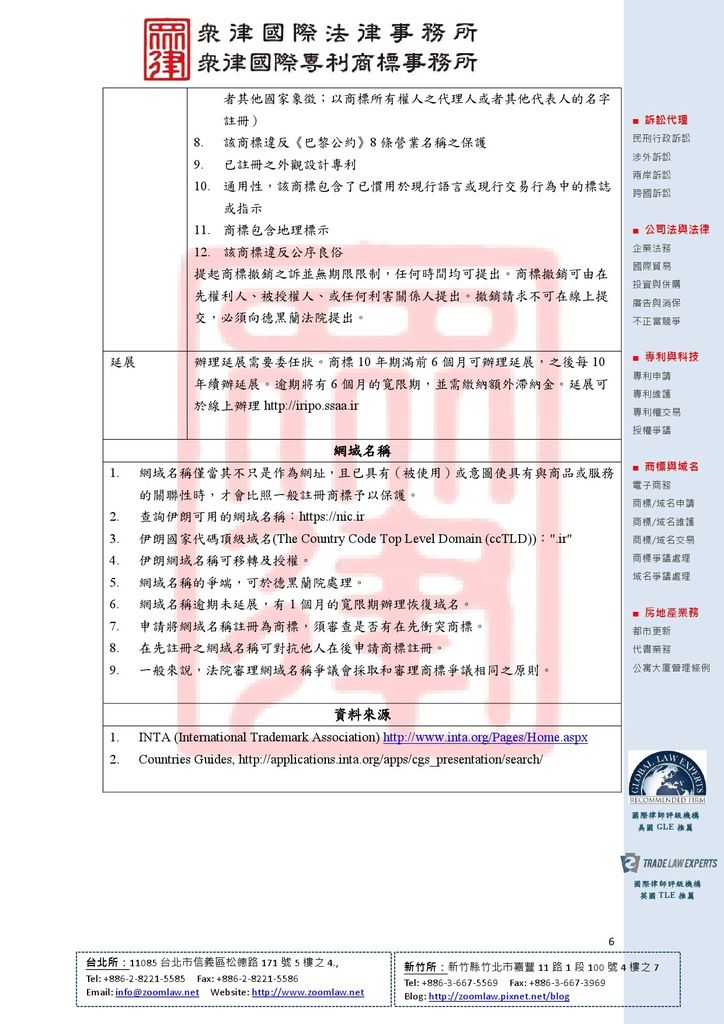
- May 25 Mon 2015 10:19
南韓商標制度介紹 眾律國際編譯中心







- May 22 Fri 2015 09:40
奧地利商標制度介紹 眾律國際編譯中心



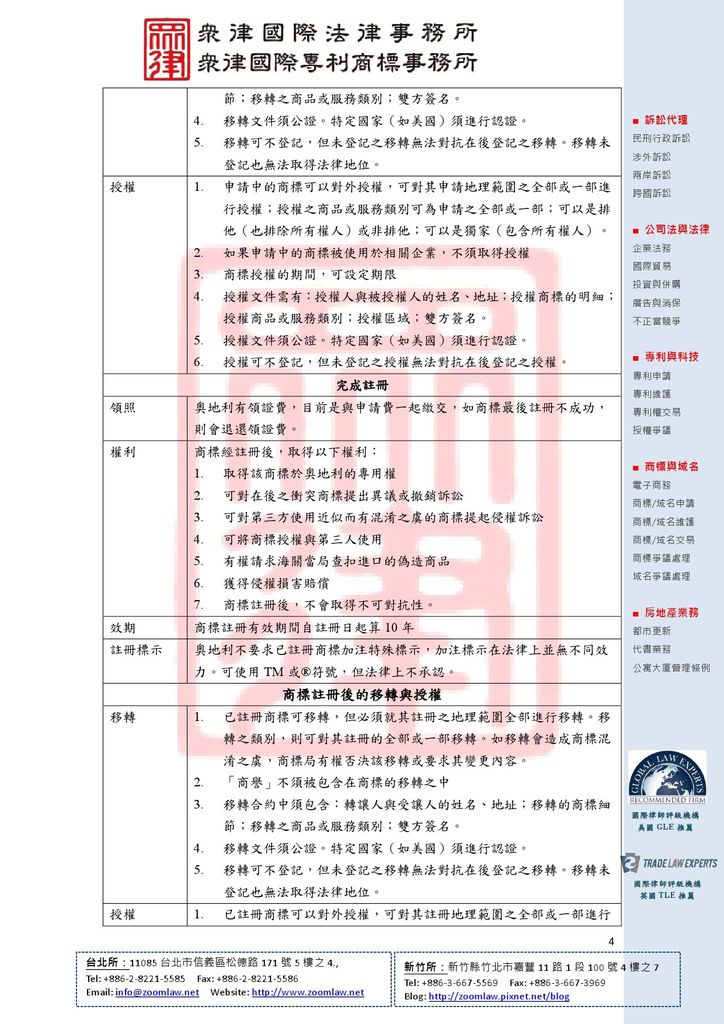


- May 20 Wed 2015 15:42
兩岸智財案件審理制度之比較 /實習律師李秋峰
兩岸智財案件審理制度之比較 實習律師李秋峰
一、前言
依中國新聞報導[1],2015年3月27日上海知識產權法院開庭審理一專利侵權案,
此案也是上海知識產權法院成立後受理的第1件案件。
本案之原告乃美國惠普公司於中國的子公司,
被告乃上海胤嘉國際貿易有限公司,原告訴稱被告未經許語,
以生產經營為目的、製造、許諾銷售型號為HP818XL的墨盒產品,
已侵害原告CN 14444523A的專利權。
緣此,本文將整理並比較兩岸關於智財案件審理制度。
二、智財案件審理制度比較
(一)中國知識產權法院設立背景及法源
2014年8月31日,中國人大常委會通過了
《全国人民代表大会常务委员会关于在北京、上海、广州设立知识产权法院的决定》
,於北京、廣州、上海三地設立知識產權法院。
而最高人民法院為因應知識產權法院的設立,
於2014年10月27日頒布了《最高人民法院关于北京、上海、广州知识产权法院案件管辖的规定》
共八條,規定了未來有關知識產權案件及目前已進行審理中案件的審級管轄。
(二)茲將兩岸智財案件審理制度,整理如下表所示
|
|
台灣 |
中國(大陸) |
|
案件種類 |
下述法律之民事、刑事、行政、強制執行案件: 1、專利法 2、商標法 3、著作權法 4、光碟管理條例 5、營業祕密法 6、積體電路電路布局保護法 7、植物品種及種苗 8、公平交易法 |
(一)专利、植物新品种、集成电路布图设 计、技术秘密、计算机软件民事和行 政案件; (二)对国务院部门或者县级以上地方人民 政府所作的涉及著作权、商标、不正 当竞争等行政行为提起诉讼的行政案 件; (三)涉及驰名商标认定的民事案件。[2] |
|
管轄審級 |
一、民事:一、二審 二、刑事:二審 三、行政:一審 |
一、專利、植物新品種、積體電路布圖設 計、技術秘密: 知識產權法院為第一審法院,高等人民 法院為終審法院。 二、著作權、商標: 基層人民法院為第一審法院,知識產權 法院為終審法院。[3] |
|
上訴審 |
一、民事/刑事:最高法院 二、行政:最高行政法院 |
|
|
法院位置 |
新北市(智慧財產法院) |
北京、上海、广州(知识产权法院) |
|
設立時間 |
2008.7.1 |
2015.1.1 |
|
技術審查官 |
有 |
尚未設置 |
三、展望
由於智慧財產案件涉及技術,尤其專利訴訟更具有较高的技術性,
而為加強智財案件審判之專業化,固然法官本身技術領域之專業能力必須提升,
但另一方面,在專業法院中引進各種技術領域專業人力,建立審判輔助機制,
以協助法官為正確之裁判。
相較於日本「裁判所調查官」、韓國「技術審理官」及我國「技術審查官」制度,
中國(大陸)之知識產權法院並未設置專業人員諮詢制度,
有鑑於此,上海智慧財產權法院相關人士表示,
鑒定人的出庭有助於法庭瞭解涉案技術,
亦給法庭在進行產品技術比對時提供重要參考意見,
今後法院將設立技術調查官、鑒定人出庭接受質詢、
具有專門知識的人出庭作證、建立技術專家諮詢庫等方式,
以提高法院技術事實查明的能力。
[1]中國新聞網 http://www.chinanews.com/fz/2015/03-27/7165667.shtml,最後流灠時間:民國104年4月27日11:00
[2]最高人民法院关于北京、上海、广州知识产权法院案件管辖的规定第1條
[3]最高人民法院关于北京、上海、广州知识产权法院案件管辖的规定第5條、第6條及第7條
- May 19 Tue 2015 10:59
土耳其商標制度介紹 眾律國際編譯中心







- May 15 Fri 2015 16:45
阿根廷商標制度介紹 眾律國際編譯中心





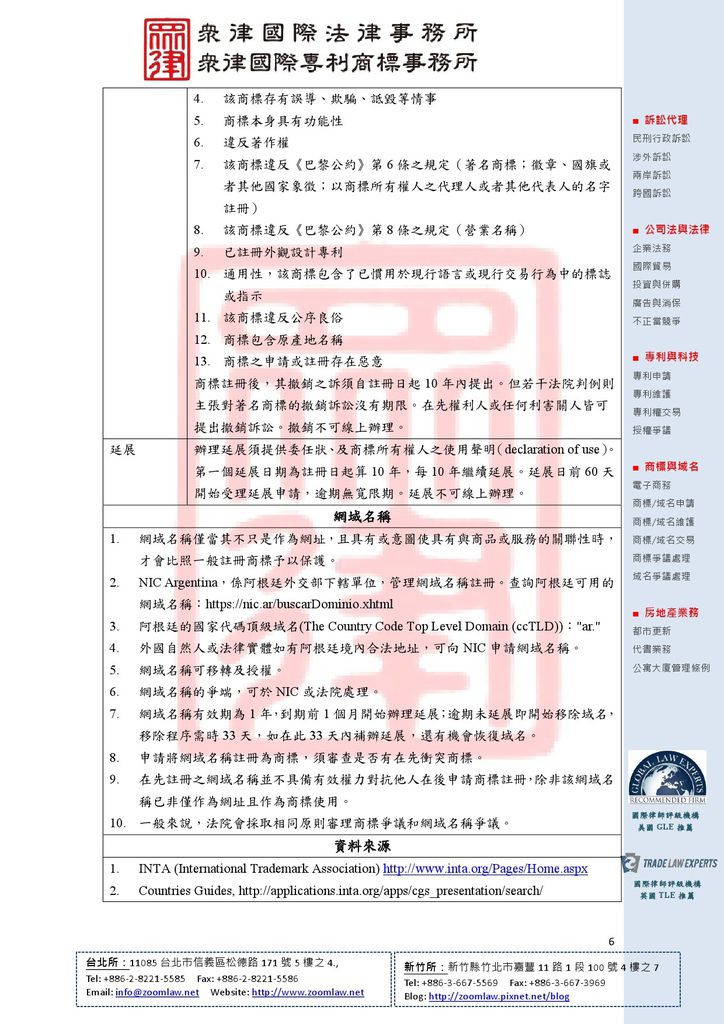
- May 15 Fri 2015 15:45
商標妨害公共秩序或善良風俗之情形 律師張源傑
商標妨害公共秩序或善良風俗之情形 律師張源傑
商標法第30 條第1 項第7 款(以下稱本款)明定商標「妨害公共秩序或善良風俗者」,不得註冊。經濟部智慧財產局於民國104年5月15日頒布商標妨害公共秩序或善良風俗審查基準做為機關審核之判斷標準,本文就此規則之審查基準重點,將商標有妨害公序良俗而不得註冊的情形敘述如下[1]。
一、與犯罪有關之名稱
「COCAINE」之意,為毒品危害防制條例之附表中行政院公告列管的第一級毒品古柯鹼;「黑市」係指非法交易之場所;「賓拉登」為全球性的恐怖組織首領,該組織被認為是美國2001年導致2986人死亡的911 襲擊事件幕後總策劃人;「MAFIA」為義大利犯罪組織黑手黨之名稱[2]。上開名稱都與犯罪行為相關,讓人容易聯想到犯罪而感到不適,也可能鼓勵犯罪,造成社會不安,故均不得註冊。
二、不尊重種族
「南蠻」經查泛指對南方少數民族的歧視性蔑稱;「生番」一詞為閩南人早年對原住民族的蔑稱;「撒奇萊雅SAKIZAYA」為原民會2007 年1 月正式認定的第13 族原住民族族名,今將此名稱指定使用於避孕器、麻將等商品,為顧及原住民族人感受,兼顧族群文化認同及民族情感,商標註冊不應許可[3]。因此,不僅商標名稱不得有歧視任何民族,亦不得將種族名稱與商品結合後,讓人對於該種族產生負面之觀感。
三、不尊重宗教
「彌勒」為佛教彌勒菩薩的簡稱,申請人將此指定使用於經營歌廳、舞廳、賭場、酒吧等聲色場所,有使宗教信徒產生不敬或藐視神明的聯想,為顧及宗教信徒的觀感,及避免破壞其宗教價值,應不得註冊[4]。
四、不尊重團體
「白色恐怖KMT TERROR」,白色恐怖指由體制方所發動的恐怖活動;KMT為kuomintang國民黨的縮寫,KMT TERROR有國民黨恐怖政策之意,易引起仇恨,挑起族群對立;「啞巴」泛指對語言障礙人士的歧視性蔑稱,故均不得註冊[5]。
五、不尊重特定個人
「陳朝松王 8 蛋」有辱罵他人之意;「馬央九」可輕易聯想到總統馬英九先生,總統為國家元首對外代表國家,其名稱應予以較高的尊重,以之作為商標,有使人產生對國家元首冒犯、揶揄之意,應不得註冊。[6]
六、心生恐怖或提倡迷信
「巫毒娃娃」是由獸骨或是稻草編製而成,各個面目猙獰,加上其儀式神秘詭異,使人產生恐怖靈異的感受,或提倡迷信的印象,故不得註冊[7]。
七、粗俗不雅
「超激buy」係為罵人不雅詞彙之台語諧音,台語為國人常用之語言,該不雅文義的發音亦為國人觀念所能認知;「王八」係為罵人不雅之言詞;「古墓春宮」刻劃古代墳墓內淫穢畫面之情景,有引人不安並違反社會一般道德觀念;「精淫島」本身為粗鄙不雅的文字組合,「精」、「淫」分別有心神、貪色放蕩之義,均因粗俗不雅之故,皆不得註冊[8]。
八、已故名人姓名之不當使用
以「鄧麗君」肖像作為商標申請註冊,可能使公眾誤認其與鄧麗君有所關聯,影響消費者權益,影響市場公平競爭;「賈伯斯」之註冊亦同此道理,都不應允許。「孔子」之註冊是允許的,但是指定使用於避孕器、馬桶、麻將、檳榔、酒、賭場等商品或服務,予人庸俗市儈之印象,與後世尊稱孔子為至聖先師之歷史形象顯有冒犯衝突,對於公共秩序或社會善良風氣有負面影響,自不得註冊[9]。
- May 12 Tue 2015 15:12
Environmental Case in Taiwan: RCA Pollution Case - Brief of the case and legal issues
|
RCA case
2015/04/17
|
By Rébecca Escaffre, Intern at Zoomlaw Attorneys-at-Law
|
Brief of the case |
RCA established subsidiaries in Taiwan between 1967 and 1970, running electronics production operations for 22 years. RCA was taken over by GE in 1986 and sold to Thomson Consumer Electronics (Thomson’s US subsidiary) in 1987 whose name turned into Technicolor in 2010. From 1988 to 1992, Thomson Consumer Electronics owned and operated the facility. It shut down in 1992.
The company RCA voluntarily poured organic solvents on the ground, leading to soil and groundwater pollution. It contaminated the worker’s water supplies and potable water. 1300 workers discovered they suffered from cancer amongst which 221 deceased. The workers and their families constituted an employees association which filed a lawsuit in 2006 for damage compensation, under article 41 of the Code of Civil Procedure. Plaintiffs’ claims amounted to 2.7 billion Taiwan dollars. This case is one of the first and most signicant class action lawsuit in Taiwan's legal history.
The Court declares Technicolor, Thomson Consumer Electronics (Bermuda) Ltd. and RCA jointly responsible for the said pollutions and, therefore, jointly liable to compensate the resulting damages. The court orders the payment of 564.4 million Taiwan dollars.
|
Legal issues |
Points of contention
- Did the defendant companies constituted a tort under articles 184 and 185 of the Civil Code? I.e. do they have to compensate the damage then generated?
- Shall RCA be held responsible for the said damages according to article 184 of the Civil Code? Shall Technicolor, Technicolor USA, Inc., Thomson Consumer Electronics (Bermuda) Ltd., GE be held responsible for the said damages according to article 185 of the Civil Code?
- If the Court lifts the corporate veil, will defendants Technicolor, Technicolor USA, Inc., Thomson Consumer Electronics (Bermuda) Ltd., GE, be held responsible for the said damages?[1]
- Is prescription alleged by the defendants valid?
- Are the plaintiffs’ requests valid in that they may trigger several compensations?
- Shall defendant RCA be held responsible to compensate the plaintiffs under article 227-1 of the Civil Code?
- Shall defendant RCA be held responsible to compensate the plaintiffs under article 7 of Labour Law?
- Did RCA violated article 487-1 of the Civil Code? If the Court lifts the corporate veil, will defendants Technicolor, Technicolor USA, Inc., Thomson Consumer Electronics (Bermuda) Ltd., GE, be held responsible for the said damages?
The Court’s decision
Liability under Tort Law
Defendants violated articles 184 and 185 of the Civil Code. It is therefore their responsibility, under the said articles, to repair the resulting damages.
RCA is held responsible for compensation under article 184 of the Civil Code.
From June 1975 to May 1991, Taiwan industry and mining inspection and the Taiwan Provincial Government found out RCA used 9 kinds of organic solvents. During this period, RCA repeatedly constituted infringement to article 184 of the Civil Code by violating “organic solvent poisoning prevention rules”, “labor safety and sanitation rules”, “lead poisoning prevention rules”, running water regulations and other protection rules.
Defendant RCA let escape in the soil of its plant in Taoyuan an excessive amount of organic solvents reaching up to 110 times the benchmark regulation: the defendant company RCA let escape several organic solvents in the underground water, a part of it content so many OVCs[2] that it reaches up to many thousand times the benchmark regulation.
Witnesses, former employees of RCA defendant, alleged RCA caused serious air pollution during its operation period and that they were in direct exposure to organic solvents as they did not take protective measures.
The International Agency for Research on Cancer (IARC), divided the substances into 5 categories according to their carcinogenicity:
- Group 1: definitely carcinogenic to humans
- Group 2A: probably carcinogenic to humans
- Group 2B: possibly carcinogenic to humans
- Group 3: not classifiable as to its carcinogenicity to humans
- Group 4: probably not carcinogenic to humans
Determination mode of the causal link
In a damage compensation case for pollution by organic solvents, trying to determine causation is very difficult, mainly because it requires a causal link that differs from public hazard.
The Japanese doctrine when it is difficult to determine the cause of the nuisance is to establish a probabilistic theory of causation and pick the preponderant evidence.
Other opinions in public nuisance cases are, when it is hard to offer evidence of the causal link and without rigorous scientific inspection certificate, the evidence of the causal link will be considered as sufficient if: “without the act, the result would not have occurred”.
Factors of occurrence of certain diseases are immunologically tested, using statistical method of “reasonable probability”, which does not affect the judgment if it is not carried out through rigorous scientific experiments. The United States use another standard: “increasing the risk of morbidity” to prove the causal link, i.e. to prove that the defendant’s behavior caused the plaintiff damage within a “reasonable medical certainty”.
According to the testimonies and to experts, and using the International Agency for Research on Cancer (IARC) and the U.S. Environmental Protection Agency (EPA) methods to determine the causal link, it is now established that the employees and their families long-term damages were caused by an exposure to organic solvents.
Relying on epidemiological studies, International Agency for Research on Cancer (IARC) classified trichloroethylene in the 3rd category of carcinogens in 1987, reclassified it in category 2A in 1995 before reclassifying it in category 1 in 2012. RCA used this organic solvent, considered by IARC and U.S. EPA as causing the diseases the employees and their families are complaining of. The immunological causal relationship between the said organic solvent and the said damages is thus established.
The employees and their families’ health damages were due to repeated violations by the defendant RCA of “organic solvent poisoning prevention rules”, “labor safety and sanitation rules”, “lead poisoning prevention rules”, running water regulations and other protection rules. The fact that the employees worked while being overexposed to the said substances for a long time period is enough to prove a general causal relationship exists.
The burden of proof
The defendant RCA did not lawfully used organic solvents and save records to protect the health of its employees, the burden of proof should thus be reversed, it is not on the plaintiffs anymore and is borne by the defendants. If the defendant does not provide evidence, it will benefit the plaintiffs. There is no need to mention again the plaintiffs were exposed to organic solvents during their work.
Compensation
Class A, the workers whose cancers have been caused by an exposure to trichlorethylene, tetrachlorethylene, trichloroethane, methylene chloride, etc. and triggered their deaths according to IARC and U.S. EPA (c.f. Schedule 3) have the said causal relationship recognized, their heirs shall be compensate with no other reason, according to article 194 of the Civil Code.
Classes B and C, the workers suffering from cancers and others diseases caused by an exposure to trichlorethylene, tetrachlorethylene, trichloroethane, methylene chloride, etc. according to IARC and U.S. EPA (c.f. Schedule 3) have the said causal relationship recognized and shall be compensate with no other reason, according to article 195 of the Civil Code; according to the probability theory, as the probability of cancer and other diseases have increased when exposure to substances identified as in Group 1 increased, the causal link is thus recognized.
Concerning the workers who do not fall into any of the said categories,who were exposed to trichlorethylene, tetrachlorethylene, trichloroethane, methylenechloride, etc. and have developed specific cancers and other health damages not related to the prolonged exposure of the said substances, especially of trichloroethylene, according to IARC and U.S. EPA and whose clinical symptoms are currently appearing, they are considered as ordinary people whose health is uninjured.
Liability
The Court lifts the corporate veil and declares defendants Technicolor, Thomson Consumer Electronics (Bermuda) Ltd., Technicolor USA, Inc., GE and RCA jointly and severally liable under Tort Law.
Defendants Technicolor, Technicolor USA Inc., Thomson Consumer Electronics (Bermuda) Ltd., and GE are jointly liable with RCA for compensation under article 185 of the Civil Code.
RCA’s insolvency
RCA defendant between July 1998 and January 1999 remitted its capital amount of 3.2 billion Taiwan dollars to French banks, making it unable to assume its debts and constituting an abuse under article 154 paragraph 2 of the Companies Act. There is no doubt RCA defendant organized its own insolvency in order to escape from its debt liability.
|
Relevant articles |
|
Article 184 |
A person who, intentionally or negligently, has wrongfully damaged the rights of another is bound to compensate him for any injury arising therefrom. The same rule shall be applied when the injury is done intentionally in a manner against the rules of morals. |
|
Article 185 |
If several persons have wrongfully damaged the rights of another jointly, they are jointly liable for the injury arising therefrom. The same rule shall be applied even if which one has actually caused the injury cannot be sure. |
|
Article 194 |
In case of death caused by a wrongful act, the father, mother, sons, daughters and spouse of the deceased may claim for a reasonable compensation in money even if such injury is not a purely pecuniary loss. |
|
Article 195 |
If a person has wrongfully damaged to the body, health, reputation, liberty, credit, privacy or chastity of another, or to another's personality in a severe way, the injured person may claim a reasonable compensation in money even if such injury is not a purely pecuniary loss. If it was reputation that has been damaged, the injured person may also claim the taking of proper measures for the rehabilitation of his reputation. |
|
Article 227- 1 |
If the creditor's personality has been injured by reason of the debtor's non-performance, the debtor shall be bound to compensate for the injury in compliance mutatis mutandis with the provisions of Article 192 to Article 195 and Article 197. |
|
Article 487- 1 |
When employee performing the services incurs an injury, he may demand to the employer for the injury, if, owing to circumstance for which he is not responsible. |
Company Act
Art 154: The liability of shareholders to the company shall, unless otherwise provided in the paragraph 2, be limited to payment in full of the shares they have subscribed.
If a shareholder abuses the company’s status as a legal entity and thus causes the company to bear specific debts and to be apparently difficult for the company to pay such debts, and if such abuse is of a severe nature, the shareholder shall, if necessary, be liable for the debts.
Code of Civil Procedure
|
Article 41 |
Multiple parties, who have common interests and may not qualify to be an unincorporated association provided in the third paragraph of the preceding Article, may appoint one or more persons from themselves to sue or to be sued on behalf of the appointing parties and the appointed parties. |
- May 11 Mon 2015 16:15
汶萊商標制度介紹 眾律國際編譯中心
